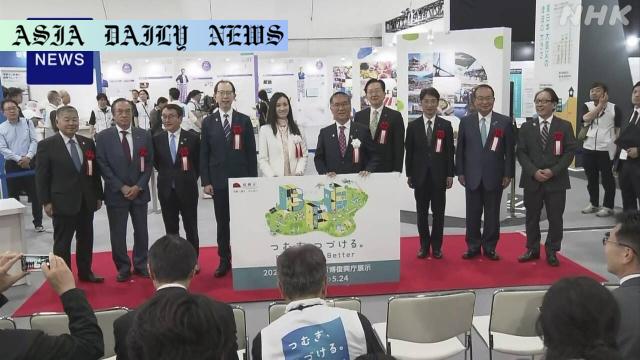Reconstruction – An exhibition featuring the recovery of areas hit by the 2011 earthquake and tsunami has opened at the 2025 Osaka Expo.

An Overview of the Exhibit at Osaka Expo
The 2025 World Expo held in Osaka focuses on sharing profound lessons from global histories and advancements. Among the prominent exhibits this year is a poignant display organized by Japan’s Reconstruction Agency, aimed at showcasing the extensive recovery efforts following the devastating 2011 Great East Japan Earthquake and Tsunami. This disaster, which caused massive destruction and loss of life in northeastern Japan, remains one of the most tragic events in the country’s recent history. The exhibit intends to serve as both a learning platform that connects visitors with the affected regions and a reminder of the resilience of humanity in the face of calamity.
Reconstruction: A Testimony of Resilience
One of the unique aspects of the exhibit is its deep dive into the reconstruction journey taken by impacted communities. Reconstruction Minister Ito Tadahiko, who inaugurated the display, emphasized the importance of connecting visitors emotionally and intellectually with the disaster-hit areas. Also present was Arakawa Shizuka, renowned Olympic figure skating champion and PR Ambassador of the Expo. Originally hailing from Miyagi Prefecture, one of the deeply affected regions, Arakawa contributed her insights, hoping the lessons from this tragedy and the rebuilding efforts pave the way for a safer, stronger future globally.
A Dynamic Experience for Visitors
The exhibition offers a multi-sensory journey, starting with a large screen near the entrance that displays real-time footage of the destruction caused by the 2011 quake and tsunami. Inside the booth, visitors find thoughtfully curated maps, panels, and photographs that document recovery milestones and emphasize education about disaster preparedness. This narrative of resilience not only reflects the rebuilding efforts in physical terms but also highlights the psychological and cultural recovery of the communities. A visitor commented on the importance of keeping these memories alive, as he pledged to share the exhibit’s lessons with his 8-year-old son.
Preserving History and Looking Ahead
As the world becomes increasingly vulnerable to natural calamities, Japan’s meticulous recovery strategies offer a blueprint for disaster response and long-term resilience. Visitors to the exhibit leave inspired with valuable insights about community-building, anti-disaster methodologies, and the unyielding spirit of the people who rebuilt their homes from the ground up. This section of the Expo will close on Saturday to make space for another northeastern Japanese-focused showcase next month, which will highlight summer festivals, offering a glimpse into the vibrant cultural heritage of the region. Together, these events provide a fuller picture of northeastern Japan’s journey—a testimony of endurance, innovation, and hope.
Conclusion: A Reminder of Hope and Unity
Exhibits like the one showcased at the 2025 Osaka Expo are more than just a presentation; they become a bridge that connects the past, present, and future. In recounting the tragedy of 2011—and celebrating the unyielding resilience of those who overcame it—the exhibit ensures that its lessons are not confined to history but instead serve as a guiding light for future generations. Through an unrelenting focus on community cohesion and safety education, Japan has presented not just its story, but a significant lesson to the world on overcoming adversity.
Commentary
The Importance of Remembering and Learning
The Reconstruction exhibit at the 2025 Osaka Expo offers visitors an essential glimpse into Japan’s resilience and their innovative approach to rebuilding lives after one of the country’s darkest periods. As someone who deeply values the importance of education through history, I find this exhibition to be a masterful blend of remembrance and forward-thinking.
Inspiration Through Tragedy
One of the most admirable aspects of this display is its ability to convey the gravity of the 2011 disaster while simultaneously inspiring hope. Seeing officials like Reconstruction Minister Ito Tadahiko and PR Ambassador Arakawa Shizuka advocate for connection and safety from a deeply personal lens brings weight and emotion to the exhibit. It’s a reminder that behind every statistic or disaster footage lies countless human stories of grief, perseverance, and hope.
Lessons for the World
I believe countries worldwide can benefit from Japan’s approach to disaster recovery. Their focus on education and preparedness is something every community should aim to emulate. Beyond the Expo, these insights must inform global disaster policies, ensuring every region is better equipped to handle the unforeseen. Exhibiting recovery success alongside cultural highlights, like summer festivals, is also a brilliant way to showcase not only resilience but the human spirit that thrives despite adversity.
Closing Reflections
This exhibition is a call-to-action, urging individuals to carry forth the lessons from Japan’s recovery into their communities. Through education, empathy, and forward planning, we can build a safer world, one step at a time. The 2025 Osaka Expo isn’t just an international event—it is history in the making.


